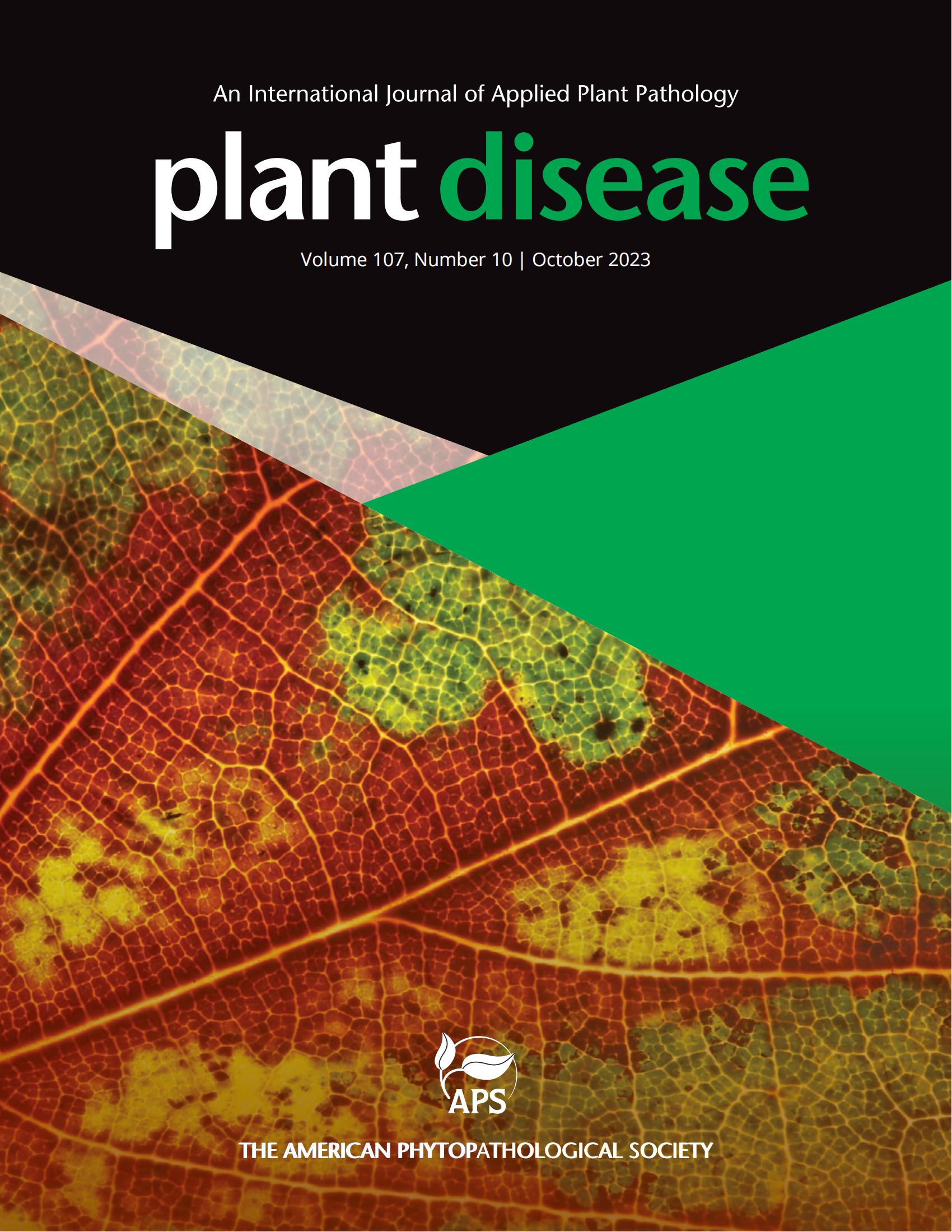在中国首次报告当归叶枯病病原 Didymella pomorum。
摘要
当归是伞形科多年生草本植物。其栽培历史悠久,在中国作为传统中药具有很高的价值(Zhang 等人,2012 年)。2023 年 9 月,在中国云南省丽江市(北纬 26.8215°,东经 100.2369°)一块约 6.7 公顷的生产田中,记录到了中药材叶枯病,平均发病率为 56%。起初,叶片上出现小的萎黄病斑。随后,病斑密度增加并逐渐融合,导致叶片变黄和枯萎。枯萎病最终导致整个叶片枯死。为了确定病原,从叶片病斑边缘切下横截面(5×5 mm2),用 1%次氯酸钠溶液进行表面消毒 3 分钟,然后用无菌蒸馏水冲洗三次。然后将其置于马铃薯葡萄糖琼脂(PDA)平板上,在 28℃、12 小时光周期条件下培养 3 天。通过单孢子分离共获得 10 个形态特征相似的分离株。在 PDA 上培养 10 天后,这些分离物的菌落形态特征是中心区域呈褐色,边缘呈白色。老化后的菌落中央起皱。分生孢子(n = 30)呈椭圆形,褐色,大小范围为 4.11-6.55 μm(平均 5.37±0.74μm)×3.17-4.62μm(平均 3.92±0.43μm)。衣藻孢子(n = 30)形成串联链,球形或椭圆形,从黄褐色到深褐色不等,大小范围为 12.30 至 13.70 μm(平均 12.98±0.46 μm)×4.20 至 5.30 μm(平均 4.63±0.26 μm)。用引物对 ITS1/ITS4(White 等,1990 年)、fRPB2-5F/fRPB2-7cR(Liu 等,1999 年)和 LR0R/LR5 (Schoch 等,2012 年)分别扩增了两个分离物的核核糖体内部转录间隔区(ITS)、RNA 聚合酶 II 第二大亚基(RPB2)和 28S 核核糖体大亚基 rRNA(LSU)区。对这些扩增子进行了双向测序和组装。这两个分离株产生了相同的核苷酸序列,其中一个代表性分离株(AsDp1)的序列已存入 GenBank。BLASTn分析表明,分离株AsDp1的ITS(PP510616)、RPB2(PP526010)和LSU(PP550143)序列分别与Didymella pomorum前型分离株CBS 354.52(MH857081、KT389616和MH868616)的序列100%、99.66%和100%相同。利用 MEGAX 中的最大似然法,根据 ITS、RPB2 和 LSU 连接核苷酸序列构建了系统发生树。AsDp1与4个D. pomorum分离株聚类。根据形态学和核苷酸序列分析,分离株 AsDp1 被确定为 D. pomorum(Chen 等,2015 年)。为确定致病性,在装有灭菌田间土壤的 7 升花盆中种植 1 年生的中华椿植株(高约 20 厘米),用分离株 AsDp1 的 1×106 分生孢子/毫升悬浮液喷洒叶面直至流出,而对照植株则用无菌水喷洒。所有植物均在 25℃、12 小时光周期条件下栽培。致病性试验一式三份,每种处理十株。15 天后,所有接种植株的叶片上都出现了大量枯萎病斑。这些症状与田间自然感染植株的症状相似,而对照植株则没有症状。随后,从病叶中重新分离出 D. pomorum,并根据其 ITS 序列和形态特征确认了其身份。加拿大曾报道过 D. pomorum 在蔷薇属植物上引起茎腐病(Ilyukhin 2022 年)。据我们所知,这是中国首次报道 D. pomorum 在中华蔷薇上引起叶枯病。这一病原学发现将为制定该病害的防治策略铺平道路。Angelica sinensis (Oliv.) Diels, is a perennial herbaceous plant of the Umbelliferae family. It has a long history of cultivation and is highly valued as a traditional Chinese medicine in China (Zhang et al. 2012). In September 2023, leaf blight on A. sinensis with an average disease incidence of 56% was recorded in an approximately 6.7-ha production field in Lijiang, Yunnan province, China (26.8215°N, 100.2369°E). At first, small, chlorotic lesions appeared on the leaves. They subsequently increased in density and gradually merged, causing leaves to yellow and wither. Ultimately the blight casused death of the entire foliage. In order to identify the causal agent, cross-sectional segments (5×5 mm2) were cut from the edge of leaf lesions, surface disinfected with a 1% sodium hypochlorite solution for 3 min and rinsed three times with sterile distilled water. They were subsequently placed on potato dextrose agar (PDA) plates and incubated for 3 days under a 12-h photoperiod at 28℃. A total of ten isolates with similar morphological characteristics were obtained by single spore isolation. After 10 days of incubation on PDA, the colony morphology of these isolates was characterized by a brownish central area with a white edge. Aged colonies became wrinkled in the center of the colony. Conidia (n = 30) were elliptical and brown, with a size range of 4.11 to 6.55 μm (average 5.37±0.74 μm) × 3.17 to 4.62 μm (average 3.92±0.43 μm). Chlamydospores (n = 30) formed chains in series, spherical or elliptical in shape, ranging from yellow-brown to dark brown, with a size range of 12.30 to 13.70 μm (average 12.98±0.46 μm) × 4.20 to 5.30 μm (average 4.63±0.26 μm). The nuclear ribosomal internal transcribed spacer region (ITS), the second largest subunit of RNA polymerase II (RPB2), and the 28S nuclear ribosomal large subunit rRNA (LSU) region of two isolates were amplified with the primer pairs ITS1/ITS4 (White et al. 1990), fRPB2-5F/fRPB2-7cR (Liu et al. 1999), and LR0R/LR5 (Schoch et al. 2012), respectively. These amplicons were sequenced bidirectionally and assembled. The two isolates produced the same nucleotide sequences, and the sequences of a representative isolate (AsDp1) were deposited in GenBank. BLASTn analyses showed that the ITS (PP510616), RPB2 (PP526010), and LSU (PP550143) sequences of isolate AsDp1 were 100%, 99.66%, and 100% identical with those of Didymella pomorum ex-type isolate CBS 354.52 (MH857081, KT389616, and MH868616), respectively. A phylogenetic tree was constructed based on the ITS, RPB2, and LSU concatenated nucleotide sequences using the maximum likelihood method in MEGAX. Isolate AsDp1 was clustered with four D. pomorum isolates. According to the morphological and nucleotide sequences analyses, isolate AsDp1 was identified as D. pomorum (Chen et al. 2015). To determine pathogenicity, 1-year-old A. sinensis plants (approximately 20 cm tall) grown in 7-liter pots filled with sterilized field soil were sprayed until runoff with a 1×106 conidia/ml suspension of isolate AsDp1 onto the foliage, while control plants were sprayed with sterile water. All plants were cultivated under a 12-h photoperiod at 25℃. The pathogenicity tests were performed in triplicate with ten plants in each treatment. After fifteen days, numerous chlorotic lesions appeared on the leaves of all inoculated plants. The symptoms were similar to those found on naturally infected plants in the field, while the control plants remained asymptomatic. Subsequently, D. pomorum was reisolated from the diseased leaves, and the identity was confirmed based on its ITS sequence and morphological characteristics. D. pomorum causing stem canker on Rosa spp. was reported in Canada (Ilyukhin 2022). To our knowledge, this is the first report of D. pomorum causing leaf blight on A. sinensis in China. This etiological finding will potentially pave the way for the development of control strategies of this disease.

 求助内容:
求助内容: 应助结果提醒方式:
应助结果提醒方式:


